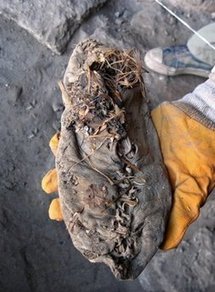
A handout image released in London and made available by University College Cork in Ireland, shows the 5,500-year-old leather moccasin.
In shape and apparent comfort it resembles loafers, currently back in vogue.
"Interestingly, the shoe is very similar to the 'pampooties' worn on the Aran Islands (in the west of Ireland) up to the 1950s," said Pinhasi.
"In fact enormous similarities exist between the manufacturing technique and style of this shoe and those found across Europe at later periods, suggesting that this type of shoe was worn for thousands of years across a large and environmentally diverse region."
Unearthed below a layer of sheep dung in a cave in Armenia, the shoe was perfectly preserved due to the dung and to the stable dry conditions.
A small 37 European size (US 7), the footwear found in Vayotz Dzor province on the Armenian-Iranian border could have belonged to either a man or a woman, according to the findings published in online journal PLoS ONE.
The shoe contained grass, the research team said, but it was unclear whether this was to keep the foot warm or keep the shape of the shoe -- like a modern shoe-tree.
------------------------------------------------------------------------
"Interestingly, the shoe is very similar to the 'pampooties' worn on the Aran Islands (in the west of Ireland) up to the 1950s," said Pinhasi.
"In fact enormous similarities exist between the manufacturing technique and style of this shoe and those found across Europe at later periods, suggesting that this type of shoe was worn for thousands of years across a large and environmentally diverse region."
Unearthed below a layer of sheep dung in a cave in Armenia, the shoe was perfectly preserved due to the dung and to the stable dry conditions.
A small 37 European size (US 7), the footwear found in Vayotz Dzor province on the Armenian-Iranian border could have belonged to either a man or a woman, according to the findings published in online journal PLoS ONE.
The shoe contained grass, the research team said, but it was unclear whether this was to keep the foot warm or keep the shape of the shoe -- like a modern shoe-tree.
------------------------------------------------------------------------









 Home
Home Politics
Politics









